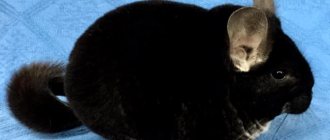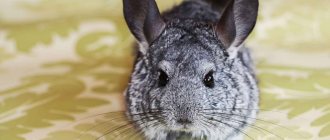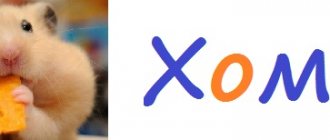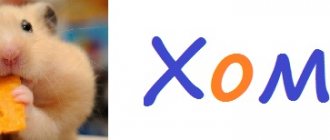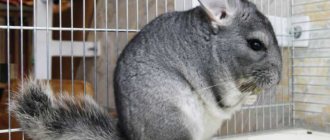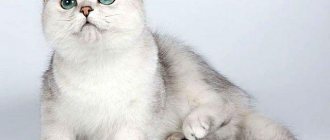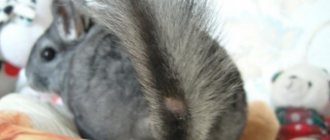- home
- Chinchilla
- Character and features
03/25/2019 Beautiful and pleasant to the touch chinchilla fur attracted people hundreds of years ago. These animals were often hunted, so their population has been significantly reduced.
The animal has adapted to living next to humans, becoming a popular pet. You can keep a rodent in spacious cages and enclosures; a completely tame rodent can be allowed to roam around the apartment. What is so fascinating about this amazing animal? An article about what a chinchilla looks like, what its character and behavior are.
Who is a chinchilla
Photos of the animal can be seen on the emblems of famous companies. The thick iridescent fur of animals is an object of worship among lovers of natural fur coats. Therefore, the number of chinchillas has decreased to the point that they are listed in the Red Book. Selection work has led to the fact that today you can find chinchillas not only of natural gray color, but also beige, pink, black, white and their many variations.
Currently, chinchillas are raised on farms for industrial purposes. Breeding rare varieties of these animals brings considerable income to nursery owners. The fur coat of these animals is not only beautiful, but also incredibly pleasant to the touch. Due to the fact that the animals do not have sweat and sebaceous glands, their fur is hypoallergenic.
Many people want to see these cute fluffies in their apartment as pets. They are kept singly, in pairs and in large families. By becoming attached to the owner, the animal becomes an affectionate and obedient friend.
Biology
The biology of chinchillas in natural habitats has been little studied; basic data on behavior, reproduction, and physiology are obtained in artificial conditions. Most of the data relates to long-tailed chinchillas due to their mass breeding in captivity.
The chinchilla's head is round in shape and its neck is short. The body length is 22-38 cm, the tail is 10-17 cm long and covered with hard guard hairs. Chinchillas are characterized by sexual dimorphism: Females are larger than males and can weigh up to 800 grams; The weight of males usually does not exceed 700 grams. Chinchillas are adapted to night life: large black eyes with vertical pupils, long (8-10 cm) whiskers, large rounded ears (5-6 cm). The chinchilla's skeleton is capable of compressing in a vertical plane, which allows animals to penetrate narrow crevices in rocks. The forelimbs are five-fingered, with four grasping fingers and one little used. The hind limbs are four-toed, one toe is turned back. Strong hind limbs are twice as long as the front ones and allow high jumps, and a highly developed cerebellum provides good coordination of movements necessary for safe movement on rocks. Chinchilla Brevicaudata
It is distinguished by its larger size, wide head, small bluish ears and short tail.
Chinchillas are omnivores. Their diet is based on various herbaceous plants, mainly cereals, legumes, also seeds, mosses, lichens, shrubs, tree bark, and small insects.
The result of living in a cold mountain climate is thick and warm fur. Chinchillas hold the record for fur density among animals - there are more than 25,000 hairs per square centimeter of skin. Such a high density is ensured by the unusual structure of the fur: 60-80 very fine hairs grow from each hair follicle. Chinchillas do not have hard guard hairs; down hairs are only 12-16 microns thick, covering hairs are 24-28 microns thick and are 4-8 mm longer than down hairs. Chinchilla fur is so dense that it cannot harbor parasites common to other fur-bearing animals. Chinchillas do not have sweat and sebaceous glands; when they get into water, their fur immediately gets wet and the animal cannot stay on the surface. To get rid of moisture, remove lost hair and clean fur, chinchillas regularly bathe in volcanic ash and fine dust.
The general composition and structure of chinchilla teeth are characteristic of many rodents. Chinchillas have 20 permanent teeth. Each half of the jaw has one incisor ( Dens incisivus
,
I
), all four incisors are covered with dark orange enamel.
The canines ( Canini
) are not developed.
Next in each half of the jaw there is one small molar - a premolar ( Praemolar
,
P
) and three molars (
Molar
,
M
). The right and left half-jaws are mirror symmetrical, so usually only one side is depicted. All teeth are rootless and grow throughout life.
Reproduction
Chinchillas are mostly monogamous. The mating season occurs between November and May in the northern hemisphere and between May and November in the southern hemisphere. The female usually gives birth to two litters per year, 1-5 (usually 2-3) cubs in each. The pregnancy of a long-tailed chinchilla lasts from 110 to 118 days (short-tailed - 128 days). Chinchillas are born well developed, with open eyes. They are completely covered with fur and weigh up to 70 grams. The lactation period lasts 6-8 weeks; at about 2 weeks from birth, chinchillas begin to try adult food (first hay). Young individuals reach sexual maturity at approximately 8 months; chinchillas of some rare colors mature later than their peers of standard or beige color. Chinchillas bear offspring for 8 years, their life expectancy in natural conditions is about 10 years, and at home it can be more than 20 years.
Chinchilla: natural habitat
Wild animals can be found in small populations in South America. The long-tailed chinchilla lives in the Andean Cordillera in the northern regions of Chile. Short-tailed - in the Andes in southern Bolivia, in the northwestern regions of Argentina and in Chile.
The chinchilla's strong hind legs allow it to make record jumps. The animal has excellent coordination thanks to its developed cerebellum. This helps them get food and escape from predators in the wild. In order to survive, they live in colonies and lead an active nocturnal lifestyle. Houses are built in rock crevices or minks are dug.
general description
Chinchilla rats live in the Andes - from Peru to Chile, found on rocky slopes up to an altitude of 5,000 m above sea level. The lifestyle is poorly studied.
The body length of chinchilla rats is 15-25 cm; Outwardly, they really resemble rats with pointed, elongated muzzles, large eyes and ears. The limbs are low. The front paws have 4 toes, the hind paws have 5. On the toes of the hind paws there are “brushes” of long, hard hair, similar to those found in eight-toothed, chinchilla and combed mice. The claws are dull and weak. The tail is shorter than the body, well furred. The fur is brownish-grayish, long, thick and soft - hence the name chinchilla rats. 30 teeth.
Recent molecular studies (2001) have shown that chinchilla rats may be closer to degus, nutria and tuco-tucos than to chinchillas.
Origin story
The history of furry animals goes back several thousand years. What animals do they descend from?
chinchilla-like, unknown to scientists. In the Cordillera, archaeologists have found the fossilized remains of prehistoric individuals, similar in genetic structure to modern chinchillas, but larger in size. These ancient animals lived about 40 thousand years ago.
In the literature, descriptions of chinchillas are found in the middle of the 16th century. The Spanish historian Pedro de Cieza wrote about these animals in his book “Chronicles of Peru”. He arrived in South America along with the conquering conquistadors. The Spaniard described beautiful fluffy animals with tails that resembled rabbits. Their skins were used to make clothing for the Peruvian Incas.
Not only the Incas admired the luxurious skins of chinchillas. Pedro de Cieza learned from the indigenous inhabitants of Peru that the Incas had conquered this territory from another Indian tribe, the Chincha. They were the first to engage in fishing and selling chinchilla skins. According to one version, the names of the animals are based on the consonant word “Chyncha”.
Although the Incas valued the fur of these animals, they kept their prey under strict control so as not to destroy the population. At the end of the 15th century, the Spaniards came to these lands. The conquerors' massive hunt for valuable rodents almost led to their complete destruction.
When shipments of skins were seen in Europe, demand jumped to stellar proportions. By the end of the last century, the animals were destroyed in most of their habitat. In the highlands of Peru they disappeared altogether. A population of millions was on the verge of extinction from the face of the earth.
Currently, in order to restore the chinchilla population, the authorities of Bolivia, Chile and Argentina have introduced a ban on hunting and export of these animals. There are severe penalties for poaching.
Reviews
Review from Alina, 25 years old
Judging by the character description, my Barney is phlegmatic. It took a long time to get used to each other. I thought that we would never become friends. But I found one place behind his ear that he lets me scratch in any mood. Now he asks to be kneeled, can freeze in one position and wait to be petted. He eats very little, there is no smell from the cage. He happily greets me from work. I am simply fascinated by the pet and can watch him for hours.
Review from Tatyana, 39 years old
We don’t have the biggest chinchilla in the world, but she already weighs 780 g at the age of four. We bought it for our daughter, but it turned out that it was for my grandfather. While his granddaughter was at school, he took the animal out of the cage and sat it next to him on the sofa, feeding it treats. The cutie just adores her grandfather. They have a tender relationship. If he leaves the room, she gets upset and makes plaintive sounds. Grandfather asked that the cage be moved to his room. They thought that Cutie would interfere with sleep. However, the smart chinchilla quickly realized that she was waking up her owner with rustling noises and was quiet at night. Amazing creation!
Is a chinchilla a rabbit or a rat?
In fact, CHINCHILLA is neither a rabbit nor a rat.
Chinchilla is a representative of the order of rodents of the chinchilla family (Chinchillidae). The genus also includes the short-tailed chinchilla (Chinchilla Liechtenstein) and its relatives - the long-tailed chinchilla (Chinchilla laniger) and the small short-tailed chinchilla (Chinchilla brevi-caudata).
Under natural conditions, the animal lives in remote areas of the mountains of South America: in the desert highlands of the Andes and Chile, Peru, Bolivia and Argentina, where it makes nests between stones. In those areas where the number of rodents is relatively large, they prefer to settle in colonies.
The reason for the misconceptions that lead to this animal being called either a rabbit or a rat lies in its appearance. In appearance, the rodent is similar to a hare and a squirrel: it has long ears, a fluffy tail and soft thick fur. Therefore, the chinchilla is often called the mountain rabbit or mountain squirrel.
The name was given to chinchillas by the Spaniards, who first arrived in South America in 1524. The word "Chinchilla" literally means "little Chincha" and comes from the name of the Chincha Indian tribe, whose representatives wore clothes made from chinchilla skins. This tribe was later conquered by the Incas, who also highly valued chinchilla fur. Clothes were made from their fur and wool, which were considered an attribute of the highest nobility; in addition, the meat of these animals was used as a remedy for tuberculosis. Under the Incas, chinchilla hunting was strictly limited. As a result, by the beginning of the European conquest of South America, chinchillas were widespread in the western part of the continent. With the arrival of the Spanish conquerors, the rate of animal capture increased sharply, and the extraction and export of skins was constantly growing.
Chinchilla as a pet: history of domestication
After the chinchilla family decreased to a critical point, attempts were made to domesticate the animals. But the description of the chinchilla turned out to be quite meager; no one knew how these fluffies lived in the wild. They led a hidden lifestyle, trying to hide from hunters and predatory animals. Due to the fact that it was unknown what to feed them and how to keep them, the animals did not survive in captivity.
The beginning of the 19th century was a turning point in the fate of the chinchilla population. A local resident sold an amazing animal to mining engineer Mathias Chapman, who worked at one of the Chilean mines. Matthias liked the new pet so much that he decided to implement the idea of breeding these animals. He hired several Indians and was able to catch 11 adult rodents in the mountains. 3 of them turned out to be females. Chapman came with them to America. On a long journey, one of the females gave birth to two babies, one of them, fortunately, survived. As a result, the engineer brought home 12 individuals, which became his first pets.
Half a century has passed, and there were already several thousand farms and nurseries in the USA and Canada. The animals were bred not only for their valuable fur, but also for sale as pets. The business brought good income to farmers. The price of one chinchilla was no less than $100.
Currently, rodents are also popular in Europe. There are a huge number of different colors and quality characteristics of skins.
The Russian Federation allowed entry into the ORDLO separatists
24 March 2022, 11:08
The authorities of the Russian Federation have allowed residents of certain areas of the Donetsk and Lugansk regions to enter Russian territory, Russian media report, citing instructions from the government. Since the checkpoints on the demarcation line between ORDLO and Ukraine were closed, the Russian Federation decided to open the border.
Sivokho scandalously described the war in Donbass
According to Advisor to the Secretary of the National Security and Defense Council Sergei Sivokho, there is an internal conflict in Ukraine in the Donbass. The scandalous statement was aired on the NASH TV channel when the prospects for the country’s entry into the North Atlantic Alliance were discussed.
4 11 March 2022, 13:15
Putin: Klimkin wants to annex “DPR”
When Donetsk separatists decided to start defending the territory under their control from the Ukrainian language, this indicates President Putin’s desire to annex part of Donbass to Russia. The former head of the Foreign Ministry of Ukraine, Pavel Klimkin, pointed out such a serious point.
3 9 March 2022, 17:52
Prystaiko demanded to increase anti-Russian sanctions
The head of the Ukrainian Foreign Ministry, Vadim Prystaiko, is a supporter of increasing economic sanctions against Russia, since this is the only method to peacefully resolve the conflict in Donbass. The economic pressure on the aggressor must be constantly intensified, the official believes.
3 February 26, 2022, 15:54
The DPR recognized the presence of Russian wax in the Donbass
The former leader of the quasi-state “DPR” Alexander Borodai admitted that so-called “volunteers” from the Russian Federation are present in the Donbass on the part of the separatists. A video with a confession was published in the telegram channel by officer of the Armed Forces of Ukraine Anatoly Stefan.
2 19 February 2022, 13:20
The Kremlin responded to the attack by Donbass separatists
According to the press secretary of the Russian head of state, Dmitry Peskov, the Kremlin is not involved in the escalation of the conflict in Donbass, which suddenly began on February 18. The press secretary provided this answer to the question whether the Russian authorities are going to take responsibility for this armed provocation.
What does a chinchilla look like: appearance
The adult individual has a completely unique appearance. The resemblance to a large mouse or rat is erroneous. People understand this when they look at the animal more carefully.
The unique charm and special energy come from these delightful animals, which cannot be confused with any other pets:
- Chinchillas have a small, rounded body. Weight ranges from 500-800 g. Females are larger and heavier than males.
- The front legs are short and underdeveloped. The hind ones are designed for jumping, so they are long and powerful. The short-tailed large chinchilla can easily fly up to a height of two meters. There are 4 toes on the hind paws, and 5 mobile and flexible toes on the front paws, with which the animal holds its prey well.
- The tail is long and densely covered with coarse hair.
- The head is round, the neck is strong and short. The ears are large and rounded. The eyes are expressive and round. A long mustache adorns its cute little face.
- An adult rodent has 20 teeth that grow throughout its life. At birth they are white, then acquire a rich, dense orange color.
- The fur coat is delicate, thick, velvety. The chinchilla feels like a plush toy. This description is very attractive for children; they ask to buy such a pet for them because of the unusually pleasant fur.
- The standard initial coat color of chinchillas is blue-gray. Nowadays, even purple chinchillas have been bred.
Newly born chinchillas are covered with delicate fur. The chinchilla sees with its beautiful big eyes from the first minute of life.
Rodents are a delicate matter
Every year the list of pet rodents expands, and this is great - you can find your one and only. You like active and funny babies, and to have a lot of them means gerbils. Peaceful, cute and with wonderful fur that is pleasant to pet - a guinea pig, chinchilla or rabbit will suit you. You are drawn to intellectual communication and frequent tactile contact - take a rat. They are attracted to larger animals with pronounced play and hunting instincts, similar to cats - pay attention to ferrets. If you want a squirrel, but don’t have enough space, get a degu rat with the same upturned tail.
Each type of rodent has its own character, degree of mobility and contact. Dimensions and weight. The colors and type of fur are what many people react to when purchasing. I would like the owners to also seriously take into account the peculiarities of keeping and feeding. Hamsters, chinchillas and every other type of rodent have their own food, cages, toys and accessories.
The lifespan of most of the most popular rodents - hamsters, rats and mice - is quite short. They live up to three years, and it will be very sad if, due to errors in feeding, the baby does not even have time to grow up. Larger pigs and chinchillas are considered long-lived, however, provided that food for chinchillas carefully and monitors the health of the animal.
Closest relatives of chinchillas
A chinchilla is not a rat, a squirrel, or a rabbit. They have only a vague general resemblance in appearance. The furry's closest relative is the porcupine, an animal with the longest and sharpest spines among mammals.
In terms of genetic structure and similarity of lifestyle, viscachas are close to them. Rodents live in the Andean Cordillera.
Interesting Facts
- These rodents have a well-developed cerebellum, which helps coordinate the movements of the animals. Therefore, they deftly cope with climbing rocks and other obstacles even at night.
- The chinchilla's whiskers - vibrissae - are also well developed. With their help, the animal gropes for food in the dark and hard-to-reach places.
- Chinchilla ears can detect an enemy at a fairly large distance.
- The animal's fur is unique - it is able to maintain the desired body temperature when the weather changes.
- Animals can reject fur if a predator grabs it. The new cover grows in a couple of months. The thick undercoat prevents parasites from settling on the animal’s body.
- Male chinchillas are easier to tame. The female can be offended if she is not the one picked up first.
- These animals are very clean. The animal does not make a toilet near the feeder and water bowl, and its feces do not emit an unpleasant odor.
- There is also no unpleasant odor from the animals themselves, since they do not have sweat glands on their bodies.
- Chinchillas are easy to train. Simple commands “sit” and “stand” can be mastered by any animal.
- They are nocturnal animals, so they sleep most of the day. No matter how much a chinchilla sleeps during the day, you cannot wake it up!
Does a chinchilla have intelligence?
Fluffies are undoubtedly smart and quick-witted. They know how to skillfully manipulate their owners, begging for a treat or another walk.
Cunning pets quickly realized that people cannot be indifferent when they see an offended expression on their faces and rush to hand them a treat or open their cage. Taking advantage of this weakness, the pet deliberately pretends to look pitiful and touches the bars of the cage with its fingers.
Such magnetic charisma emanates from animals that it is impossible to resist.
Classification
The family includes 3 genera.
- Genus Chinchilla rat ( Abrocoma
) Bennett's chinchilla rat (
Abrocoma bennettii
) - Bolivian chinchilla rat ( Abrocoma boliviensis
) - Abrocoma budini
- Abrocoma famatina
- Ashy chinchilla rat ( Abrocoma cinerea
), or gray chinchilla rat[1] - Abrocoma schistacea
- Peruvian chinchilla rat ( Abrocoma uspallata
) - Abrocoma vaccarum
- Genus Cuscomys
Peruvian chinchilla rat ( Cuscomys ashaninka
)
Chinchilla rats are rare animals, although they are not a protected species. Sometimes they are hunted for their skins, although they are fragile and of little value.
Features of collective and solitary keeping of animals
Rodents in captivity will live normally and will not be sad about the fact that they do not have a mate. In the wild, they need company to fend for themselves and protect their cubs. There are some nuances that the owner of a furry cat should know about:
- For breeding you need to buy a ready-made pair.
- A female and several males can live and feel normal in one cage.
- The two boys get along well with each other.
- Two females will never be able to coexist peacefully in the same cage.
These features must be taken into account when purchasing a furry pet.
Character and behavior
It is difficult to guess what kind of character each chinchilant will have. They are all different, and according to their character they can be divided into 4 types, like people:
- Cholerics. Mobile and active. During the day they sleep lightly and wake up at the slightest rustle. They are timid and can rush around in fright, sweeping away all the attributes in the cage. When they are awake, they constantly explore everything around them.
- Sanguines. Curious and active, but not shy. They are not afraid of loud sounds and rustling. They don’t like to sit in one place; they happily walk around the apartment.
- Phlegmatic people. Balanced sleepyheads. They move slowly and can look at everything carefully for a long time. They prefer sleep to active games.
- Melancholic people. Quiet, calm, but timid. When there are loud sounds, they can hide in a far corner and sit there for half a day. While walking around the apartment, he can find a secluded crevice and hide there.
Reviews from owners indicate that sanguine people are most suitable for domestication. They have a good memory, they are imbued with trust in the owner. They can also be tamed and phlegmatic. They sit on laps and love to be petted. But it will take a long time to tame them.
Cholerics and melancholics are distrustful of people and are difficult to tame. They are constantly distracted by any extraneous noise. But they are also big cuties thanks to their lively, inquisitive nature. If you manage to tame a choleric person, you will get a cheerful friend.
Females of any psychotype are more intelligent and easier to become tame pets.
The house we live in
It is impossible to properly arrange a home for a rodent without special knowledge. It is not always enough to set yourself the task of buying a cage . Sometimes an aquarium (terrarium) or a display case is preferable. A house is also absolutely necessary. It is important to guess the sizes. For example, even the most spacious cage for squirrels will be small; they require an enclosure for constant vigorous activity. A chinchilla cage is taller than a rabbit cage. Ferrets do not need a large cage; they walk a lot “by themselves.”
When getting a hamster at the request of a child, owners often care about only one thing: that the hamster cage is inexpensive and reliable. Where will she stand? All domestic rodents are tender babies and suffer from drafts, which large people do not pay attention to. You can't put the cage on the floor, because it's cooler there. It is better to immediately purchase a special stand.
What to put on the bottom of the cage? And at this point our cute rodents show great diversity. Some people like to dig, while others like to scatter the covering. Ferrets spend little time in cages, but they must have a litter tray next to the house. Cat litter is quite suitable for them. But litter for a hamster ; you should not use newspapers or just paper. Don’t forget, smell is the main problem of keeping a rodent in an apartment. The branded filler does not have to be changed daily. Chinchillas can be toilet trained, but bedding is still required. This amazing animal does not smell, but excrement will indicate the presence of a rodent in the house, so it is better to purchase chinchilla litter . And immediately - special sand for swimming.
As you can see, each rodent has its own approach. And feeding is a whole science. It would seem that a rat is a rat. But it turns out that the wire-haired degu and the white rat need to be fed differently. Information about the nutrition of rodents gleaned from children's cartoons does not correspond to reality. It will be safer to buy commercially produced hamster food Let the hamster live a little longer.
